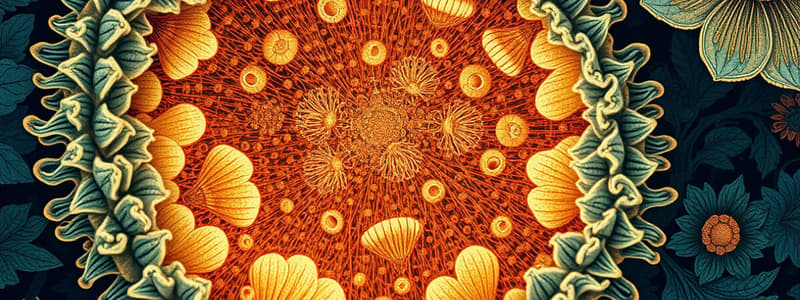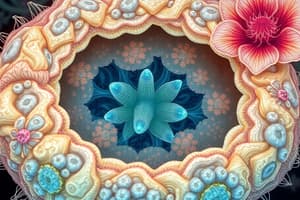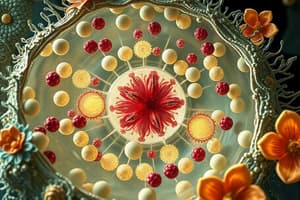Podcast
Questions and Answers
Which organelle is responsible for generating energy through cellular respiration?
Which organelle is responsible for generating energy through cellular respiration?
- Mitochondria (correct)
- Ribosome
- Chloroplast
- Nucleus
Plant cells contain both chloroplasts and large vacuoles.
Plant cells contain both chloroplasts and large vacuoles.
True (A)
What is the process called through which DNA is replicated?
What is the process called through which DNA is replicated?
Semi-conservative replication
The __________ is the point where sister chromatids are held together.
The __________ is the point where sister chromatids are held together.
Match each type of cell division with its description:
Match each type of cell division with its description:
What type of chromosomes determine an individual's sex?
What type of chromosomes determine an individual's sex?
RNA contains thymine as one of its nitrogenous bases.
RNA contains thymine as one of its nitrogenous bases.
What is the gel-like substance where cellular processes occur called?
What is the gel-like substance where cellular processes occur called?
What is the main purpose of the karyotype analysis?
What is the main purpose of the karyotype analysis?
Nondisjunction occurs when homologous chromosomes separate correctly during meiosis.
Nondisjunction occurs when homologous chromosomes separate correctly during meiosis.
What are the building blocks of proteins?
What are the building blocks of proteins?
The ______ structure of a protein involves the interaction among multiple polypeptide chains.
The ______ structure of a protein involves the interaction among multiple polypeptide chains.
Match the following terms with their definitions:
Match the following terms with their definitions:
Which enzyme is NOT involved in DNA replication?
Which enzyme is NOT involved in DNA replication?
DNA contains ribose sugar and is single-stranded.
DNA contains ribose sugar and is single-stranded.
Name one common structural feature of proteins.
Name one common structural feature of proteins.
Flashcards are hidden until you start studying
Study Notes
Cell Types
- Animal cells are eukaryotic, lacking cell walls and chloroplasts; they rely on cellular respiration for energy.
- Plant cells are eukaryotic, featuring cell walls, chloroplasts (for photosynthesis), and larger vacuoles for storage.
- Cell walls provide structural support and protection in plants, while the cytoplasm is the site of various cellular activities.
Organelles and Their Functions
- Ribosomes synthesize proteins, essential for cell functions.
- Mitochondria generate energy through cellular respiration, critical for cell survival.
- Vacuoles store water, waste, and nutrients; plant cells have larger vacuoles compared to animal cells.
- Chloroplasts enable photosynthesis in plant cells, converting light energy into chemical energy.
- The cell membrane regulates the entry and exit of substances, maintaining homeostasis.
DNA and RNA
- DNA is a double-stranded molecule housing genetic information with a backbone of phosphate-sugar and nitrogenous bases: adenine, thymine, cytosine, and guanine.
- RNA, a single-stranded molecule, contains uracil instead of thymine and plays roles in protein synthesis and gene regulation.
DNA Replication
- Helicase unwinds DNA strands, allowing replication to occur.
- DNA polymerase adds complementary nucleotides to create new DNA strands.
- Semi-conservative replication produces two DNA molecules, each containing one old and one new strand.
Chromosomes
- Chromatin is a complex of DNA and proteins that packages DNA into chromosomes.
- Duplicated chromosomes have two identical strands called chromatids, joined at a centromere.
- Homologous chromosomes carry the same genes but may differ in alleles; autosomes are non-sex chromosomes, while sex chromosomes determine an individual's gender.
Cell Division
- Mitosis yields two genetically identical daughter cells, retaining the same chromosome number as the parent.
- Meiosis produces four haploid gametes, which are genetically diverse.
- Interphase, a non-dividing phase, includes cell growth and DNA replication.
Stages of Mitosis
- Prophase involves chromosome condensation and spindle formation.
- In metaphase, chromosomes align at the cell's equator.
- Anaphase sees the separation of chromatids by spindle fibers.
- Telophase culminates with new nuclear membranes forming around separated chromosomes.
Karyotype
- A karyotype organizes chromosomes based on size, banding pattern, and centromere position, useful for detecting chromosomal abnormalities.
- Nondisjunction refers to the failure of chromosomes to separate properly, often leading to genetic disorders.
Proteins and Their Structure
- Proteins consist of amino acids linked by peptide bonds, creating polypeptide chains.
- The primary structure is defined by the amino acid sequence; secondary structure involves α-helices and β-sheets formed through hydrogen bonding.
- Tertiary structure represents the overall 3D folding of the polypeptide, while quaternary structure involves the assembly of multiple polypeptide chains.
Biomacromolecules
- Biomacromolecules are vital for life and comprise carbohydrates, lipids, proteins, and nucleic acids, with nucleic acids playing a key role in genetic information storage and transmission.
Protein Folding
- Proper protein folding is essential for functionality; errors in this process can lead to diseases, emphasizing the importance of the hierarchy in protein structure.
Studying That Suits You
Use AI to generate personalized quizzes and flashcards to suit your learning preferences.



